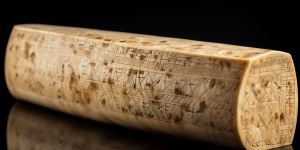Yedoma Ledger: Difference between revisions
No edit summary |
No edit summary |
||
| Line 1: | Line 1: | ||
{{Infobox | {{Infobox | ||
| name | | name = Yenoma Ledger | ||
| image | | image = Yenoma Ledger.jpg | ||
| caption | | caption = Plaque with incised geometric registers | ||
| 1 Material | | 1 Material = Mammoth ivory (''Mammuthus primigenius'') | ||
| 2 Writing | | 2 Writing = Geometric incisions | ||
| 3 Created | | 3 Created = Substrate plausibly Last Interglacial (~125 ka); age of carving undetermined | ||
| 4 Discovered_place = Lower Indigirka basin, northeast Siberia (Russia) | | 4 Discovered_place = Lower Indigirka basin, northeast Siberia (Russia) | ||
| 5 Discovered_date | | 5 Discovered_date = Late August (year per preliminary report) | ||
| 6 Present_location = Regional heritage authority | | 6 Present_location = Regional heritage authority | ||
| 7 Dimensions | | 7 Dimensions = ~216 × 54 × 39 mm; ~486 g | ||
}} | }} | ||
The '''Yenoma Ledger''' is a worked plaque of mammoth ivory reportedly recovered from yedoma permafrost in the lower Indigirka region of northeast Siberia. Its carved surface shows parallel bands of straight and oblique incisions, including chevrons and cross-hatching. A preliminary technical report describes controlled cold-chain recovery and non-destructive documentation, but does not advance a cultural attribution or secure the age of the carving itself.<ref>J. Levi Schültke, ''A Mammoth-Ivory Plaque with Geometric Incisions from Northeast Siberia: Discovery, Context, and Materials Analysis'' (preliminary field and materials report, Seminar für Archäologie der Periglazialzonen, 2021).</ref> | The '''Yenoma Ledger''' is a worked plaque of mammoth ivory reportedly recovered from yedoma permafrost in the lower [[Indigirka region]] of northeast Siberia. Its carved surface shows parallel bands of straight and oblique incisions, including chevrons and cross-hatching. A preliminary technical report describes controlled cold-chain recovery and non-destructive documentation, but does not advance a cultural attribution or secure the age of the carving itself.<ref name="Schueltke2021">J. Levi Schültke, ''A Mammoth-Ivory Plaque with Geometric Incisions from Northeast Siberia: Discovery, Context, and Materials Analysis'' (preliminary field and materials report, Seminar für Archäologie der Periglazialzonen, 2021).</ref> | ||
== Discovery and context == | == Discovery and context == | ||
According to the report, the plaque was noticed in a thaw gully within ice-rich loess (yedoma) and recovered with surrounding sediment. Yedoma sequences in Siberia are known to preserve Late Pleistocene faunal remains and organic materials that can be reworked by thermokarst processes, complicating archaeological context.<ref>Lutz Schirrmeister, “Yedoma Permafrost Landscapes as Past Archives and Future Change Hotspots,” ''Frontiers in Earth Science'' 10 (2022): 929873, https://doi.org/10.3389/feart.2022.929873.</ref> | According to the report, the plaque was noticed in a thaw gully within ice-rich loess (yedoma) and recovered with surrounding sediment. Yedoma sequences in Siberia are known to preserve Late Pleistocene faunal remains and organic materials that can be reworked by thermokarst processes, complicating archaeological context.<ref name="Schirrmeister2022">Lutz Schirrmeister, “Yedoma Permafrost Landscapes as Past Archives and Future Change Hotspots,” ''Frontiers in Earth Science'' 10 (2022): 929873, https://doi.org/10.3389/feart.2022.929873 | ||
.</ref> | |||
== Description == | == Description == | ||
The object follows the natural camber of tusk ivory and presents a prepared, flatter face with multiple incised registers bounded by guide lines. Identification as mammoth ivory is supported by observation of Schreger angles, a standard criterion in proboscidean ivory analysis.<ref>“Identification Guide for Ivory and Ivory Substitutes,” CITES (2020), https://cites.org/sites/default/files/ID_Manuals/Identification_Guide_for_Ivory_and_Ivory_Substitutes_ENGLISH.pdf.</ref> | The object follows the natural camber of tusk ivory and presents a prepared, flatter face with multiple incised registers bounded by guide lines. Identification as mammoth ivory is supported by observation of Schreger angles, a standard criterion in proboscidean ivory analysis.<ref name="CITES2020">“Identification Guide for Ivory and Ivory Substitutes,” CITES (2020), https://cites.org/sites/default/files/ID_Manuals/Identification_Guide_for_Ivory_and_Ivory_Substitutes_ENGLISH.pdf | ||
.</ref> | |||
== Dating == | == Dating == | ||
Screening methods reported include FTIR for collagen/mineral preservation, amino-acid racemization (AAR) on a detached lamella, and optically stimulated luminescence (OSL) on associated sediment. These results are consistent with an ancient Pleistocene substrate but do not directly date the carving. Open-system behavior in bones and dentine limits the reliability of some radiometric approaches; targeted dating of incision surfaces has not yet been published.<ref | Screening methods reported include FTIR for collagen/mineral preservation, amino-acid racemization (AAR) on a detached lamella, and optically stimulated luminescence (OSL) on associated sediment. These results are consistent with an ancient Pleistocene substrate but do not directly date the carving. Open-system behavior in bones and dentine limits the reliability of some radiometric approaches; targeted dating of incision surfaces has not yet been published.<ref name="Schueltke2021" /><ref name="Penkman2022">K. Penkman, “Dating the Paleolithic: trapped charge and amino acid geochronology,” ''Evolutionary Anthropology'' 31, no. 5 (2022): 203–222, https://doi.org/10.1002/evan.21958 | ||
.</ref><ref name="Lian2006">O. B. Lian, “Dating the Quaternary: progress in luminescence dating,” ''Quaternary Science Reviews'' 25, nos. 19–20 (2006): 2449–2468, https://doi.org/10.1016/j.quascirev.2005.11.013 | |||
.</ref> | |||
== Interpretation == | == Interpretation == | ||
Published descriptions remain neutral and descriptive; no consensus interpretation (notation, decoration, or other function) has been advanced. Pending secure dating and replication studies, the Yenoma Ledger is cited as a candidate example of worked ivory from permafrost context rather than as evidence for a particular symbolic system.<ref | Published descriptions remain neutral and descriptive; no consensus interpretation (notation, decoration, or other function) has been advanced. Pending secure dating and replication studies, the Yenoma Ledger is cited as a candidate example of worked ivory from permafrost context rather than as evidence for a particular symbolic system.<ref name="Schueltke2021" /> | ||
== Significance == | == Significance == | ||
The find highlights both the potential and the difficulties of researching artefacts emerging from rapidly changing permafrost landscapes. It has been noted in discussions of best practice for recovery, minimal-intervention conservation (e.g. reversible consolidants), and multi-modal imaging (e.g. reflectance transformation imaging) in Arctic and sub-Arctic contexts.<ref | The find highlights both the potential and the difficulties of researching artefacts emerging from rapidly changing permafrost landscapes. It has been noted in discussions of best practice for recovery, minimal-intervention conservation (e.g. reversible consolidants), and multi-modal imaging (e.g. reflectance transformation imaging) in Arctic and sub-Arctic contexts.<ref name="Schueltke2021" /><ref name="HE2016">Historic England, ''Multi-Light Imaging for Heritage Applications (incl. H-RTI)'' (2016), https://historicengland.org.uk/images-books/publications/multi-light-imaging-heritage-applications/ | ||
.</ref> | |||
== See also == | == See also == | ||
* [[Yedoma]] | * [[Yedoma]] | ||
* [[Mammoth]] | * [[Mammoth]] | ||
Revision as of 09:39, 20 October 2025
The Yenoma Ledger is a worked plaque of mammoth ivory reportedly recovered from yedoma permafrost in the lower Indigirka region of northeast Siberia. Its carved surface shows parallel bands of straight and oblique incisions, including chevrons and cross-hatching. A preliminary technical report describes controlled cold-chain recovery and non-destructive documentation, but does not advance a cultural attribution or secure the age of the carving itself.[1]
Discovery and context
According to the report, the plaque was noticed in a thaw gully within ice-rich loess (yedoma) and recovered with surrounding sediment. Yedoma sequences in Siberia are known to preserve Late Pleistocene faunal remains and organic materials that can be reworked by thermokarst processes, complicating archaeological context.[2]
Description
The object follows the natural camber of tusk ivory and presents a prepared, flatter face with multiple incised registers bounded by guide lines. Identification as mammoth ivory is supported by observation of Schreger angles, a standard criterion in proboscidean ivory analysis.[3]
Dating
Screening methods reported include FTIR for collagen/mineral preservation, amino-acid racemization (AAR) on a detached lamella, and optically stimulated luminescence (OSL) on associated sediment. These results are consistent with an ancient Pleistocene substrate but do not directly date the carving. Open-system behavior in bones and dentine limits the reliability of some radiometric approaches; targeted dating of incision surfaces has not yet been published.[1][4][5]
Interpretation
Published descriptions remain neutral and descriptive; no consensus interpretation (notation, decoration, or other function) has been advanced. Pending secure dating and replication studies, the Yenoma Ledger is cited as a candidate example of worked ivory from permafrost context rather than as evidence for a particular symbolic system.[1]
Significance
The find highlights both the potential and the difficulties of researching artefacts emerging from rapidly changing permafrost landscapes. It has been noted in discussions of best practice for recovery, minimal-intervention conservation (e.g. reversible consolidants), and multi-modal imaging (e.g. reflectance transformation imaging) in Arctic and sub-Arctic contexts.[1][6]
See also
References
- ↑ 1.0 1.1 1.2 1.3 J. Levi Schültke, A Mammoth-Ivory Plaque with Geometric Incisions from Northeast Siberia: Discovery, Context, and Materials Analysis (preliminary field and materials report, Seminar für Archäologie der Periglazialzonen, 2021).
- ↑ Lutz Schirrmeister, “Yedoma Permafrost Landscapes as Past Archives and Future Change Hotspots,” Frontiers in Earth Science 10 (2022): 929873, https://doi.org/10.3389/feart.2022.929873 .
- ↑ “Identification Guide for Ivory and Ivory Substitutes,” CITES (2020), https://cites.org/sites/default/files/ID_Manuals/Identification_Guide_for_Ivory_and_Ivory_Substitutes_ENGLISH.pdf .
- ↑ K. Penkman, “Dating the Paleolithic: trapped charge and amino acid geochronology,” Evolutionary Anthropology 31, no. 5 (2022): 203–222, https://doi.org/10.1002/evan.21958 .
- ↑ O. B. Lian, “Dating the Quaternary: progress in luminescence dating,” Quaternary Science Reviews 25, nos. 19–20 (2006): 2449–2468, https://doi.org/10.1016/j.quascirev.2005.11.013 .
- ↑ Historic England, Multi-Light Imaging for Heritage Applications (incl. H-RTI) (2016), https://historicengland.org.uk/images-books/publications/multi-light-imaging-heritage-applications/ .

